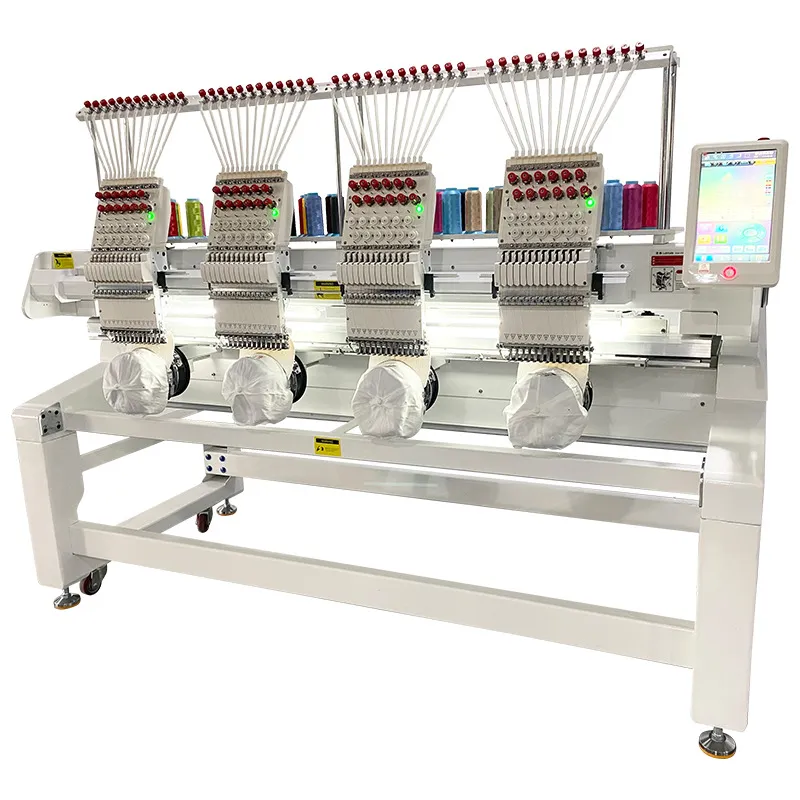May . 22, 2025 17:34 Back to list
Versatile Embroidery Solutions with a 4 Head Embroidery Machine
In today’s competitive textile and garment customization industry, embroidery businesses need equipment that combines speed, precision, and versatility. The Igwe akwa akwa 4 isi offers a powerful solution for medium to large-scale operations that require high output without sacrificing quality. Equipped with advanced needle systems and flat or cap embroidery capability, this type of machine helps manufacturers meet diverse client demands across fashion, branding, and promotional sectors. With modern control systems and robust build quality, the 4-head configuration ensures efficiency and reliability even in high-volume production environments.

Enhanced Production Efficiency with a 4 Head Embroidery Machine
A Igwe akwa akwa 4 isi significantly increases productivity by enabling simultaneous stitching on four garments. Whether running identical designs or duplicating complex logos, the synchronized operation ensures consistency and speed. This type of machine is especially beneficial for bulk orders, such as uniforms, team gear, and retail merchandise.
Each head operates under centralized digital control, offering real-time monitoring, error detection, and thread break alerts. With this setup, operators can manage large production runs with minimal supervision. Furthermore, models with adjustable hoop sizes make it easier to switch between product types, from shirts to caps to bags.
Precision and Adaptability in a Flat Embroidery Machine
A Flat Embroidery Machine is ideal for large surface designs on garments such as jackets, towels, and linens. Unlike cap-oriented machines, it provides a stable, flat surface that eliminates distortion when embroidering logos or detailed patterns. This makes it the preferred option for fashion brands and industrial textile decorators that prioritize stitch accuracy and design complexity.
Flatbed systems often support a broader embroidery area, allowing designers more freedom in layout. Many machines also come with digitizing software compatibility, making them suitable for intricate multi-layered designs. In high-speed operations, a Flat Embroidery Machine complements multi-head configurations by handling specific jobs that require a larger embroidery field.
Needle Configuration: Choosing Between a 12 Needle Embroidery Machine and a 15 Needle Embroidery Machine
When selecting equipment, the choice between a Igwe eji akwa agịga 12 and a Igwe eji akwa agịga 15 often comes down to design complexity and color range. A Igwe eji akwa agịga 12 offers ample flexibility for most standard jobs, accommodating up to twelve thread colors without requiring manual thread changes.
However, a Igwe eji akwa agịga 15 provides even greater flexibility, ideal for highly detailed, multi-color logos or images. It reduces downtime by minimizing color swaps during production, thus increasing efficiency for large orders. Both configurations support automatic threading, quick color change, and programmable thread tension, streamlining the entire production process.
Meeting Market Demand with a Cap Embroidery Machine
The growing popularity of personalized headwear has created a strong demand for the Cap Embroidery Machine. This specialized equipment is designed to handle the curved surface of hats, offering precise alignment and firm frame support to prevent slippage or distortion.
A modern Cap Embroidery Machine includes features like rotating cap frames, cap-specific design settings, and reinforced hooping systems. These functions ensure accurate placement of logos and artwork on a wide range of hat styles, from baseball caps to trucker hats. For businesses targeting sports teams, corporate branding, or fashion caps, such a machine is essential for professional results.
Combining Flat and Cap Embroidery Functions in a Multi-Needle, Multi-Head Setup
A Igwe akwa akwa 4 isi that supports both Flat Embroidery Machine and Cap Embroidery Machine capabilities offers unmatched versatility. Combined with either Igwe eji akwa agịga 12 or Igwe eji akwa agịga 15 configurations, this setup allows businesses to handle diverse orders without switching between machines or workflows.
By equipping one machine with the capacity to switch between flat and curved items, operators reduce downtime and optimize space. Multi-needle systems handle intricate designs without manual intervention, and four-head functionality ensures high-volume capability. This combination is particularly valuable for growing businesses looking to expand product offerings while controlling overhead.
4 Head Embroidery Machine FAQs
What are the benefits of a Igwe akwa akwa 4 isi over single or dual head machines?
A Igwe akwa akwa 4 isi significantly boosts production by embroidering four items at once, ideal for medium to large businesses looking to fulfill bulk orders quickly and efficiently.
Can a Flat Embroidery Machine be used for cap embroidery as well?
No, a Flat Embroidery Machine is optimized for flat garments and surfaces. For hats or caps, a dedicated Cap Embroidery Machine is recommended to ensure proper tension and design accuracy.
How do I choose between a Igwe eji akwa agịga 12 and a Igwe eji akwa agịga 15?
Choose a Igwe eji akwa agịga 12 for standard multi-color designs, and a Igwe eji akwa agịga 15 if you frequently work with complex, high-color-count logos to reduce thread changes and improve efficiency.
What makes a Cap Embroidery Machine different from regular embroidery machines?
A Cap Embroidery Machine features specialized curved frames and mechanisms designed to hold hats securely, allowing precise embroidery along curved surfaces without design distortion.
Can a Igwe akwa akwa 4 isi combine flat and cap embroidery functions?
Yes, many Igwe akwa akwa 4 isi models can be configured with both flat and cap attachments, allowing flexible production and seamless switching between different product types.
-
Single Head Embroidery Machine: The Craftsmanship of Exquisite Embroidery
AkụkọJul.24,2025
-
Embroidered Machine Single Head: A Dynamic and Ingenious Work in the Field of Embroidery
AkụkọJul.24,2025
-
Embroidered Machine 4 Head: A Quartet of Embroidery Efficiency
AkụkọJul.24,2025
-
Embracery Machine 2 Head: The Twin Power of Efficient Embroidery
AkụkọJul.24,2025
-
Babylock 6 Needle Embroidery Machine: An Excellent Choice for Exquisite Embroidery Craftsmanship
AkụkọJul.24,2025
-
6-Needle Home Embracery Machine: A Versatile Stage for Fingertip Art
AkụkọJul.24,2025

Copyright © 2025 Xingtai Pufa Trading Co., Ltd All Rights Reserved. Sitemap | Privacy Policy
